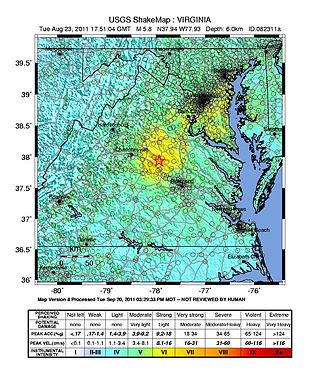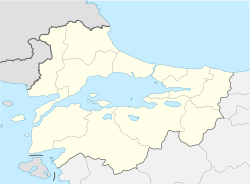
The 2006 Greece earthquake – also known as the Kythira earthquake – occurred on January 8 at 13:34:53 local time and was felt throughout the entire eastern Mediterranean basin. The earthquake an magnitude 6.7 and a maximum Mercalli intensity of VII. Its epicentre was located just off the island of Kythira about 200 kilometres (120 mi) south of Athens.

The 1999 İzmit earthquake had a moment magnitude of 7.6 and struck Kocaeli Province, Turkey on 17 August. Between 17,127 and 18,373 people died as a result, and the damage was estimated at US$6.5 billion. It was named for the epicenter's proximity to the northwestern city of İzmit. The earthquake occurred at 03:01 local time at a shallow depth of 15 km (9.3 mi). A maximum Mercalli intensity of X (Extreme) was observed. The earthquake lasted for 37 seconds, causing seismic damage, and is widely remembered as one of the deadliest natural disasters in modern Turkish history.
The 1959 Hebgen Lake earthquake occurred in the western United States on August 17 at 11:37 pm (MST) in southwestern Montana.

The 1983 Coalinga earthquake struck at 4:42 p.m. Monday, May 2 of that year, in Coalinga, California.
The 2008 Dodecanese earthquake occurred near Kattavia on the island of Rhodes in the eastern Mediterranean Sea on 15 July. The quake struck at 06:26 a.m. local time (UTC+3) and one woman was killed when she slipped and fell as she tried to flee her home. However, the earthquake did not cause any major damage. The earthquake was felt across the entire eastern Mediterranean, as far west as Libya, and inland as far as Damascus.

The 1953 Yenice–Gönen earthquake occurred at 21:06 local time (19:06 UTC on 18 March in the province of Çanakkale and Balıkesir in the Marmara Region at western Turkey. It had a surface-wave magnitude of 7.5 and a maximum felt intensity of IX on the Mercalli intensity scale. It caused widespread damage, killing 1,070 and causing damage that was estimated at US$3,570,000 repair value.

The 1953 Ionian earthquake struck the southern Ionian Islands in Greece on August 12. In mid-August, there were over 113 recorded earthquakes in the region between Kefalonia and Zakynthos, and the most destructive was the August 12 earthquake. The event measured 6.8 on the moment magnitude scale, raised the whole island of Kefalonia by 60 cm (24 in), and caused widespread damage throughout the islands of Kefalonia and Zakynthos. The maximum felt intensity of shaking was X (extreme) on the Mercalli intensity scale. Between 445 and 800 people were killed.
The 2010 Elazığ earthquake was a 6.1 Mw earthquake that occurred on 8 March 2010 at 02:32 UTC. The epicentre was Başyurt in Elazığ Province, in eastern Turkey. Initial reports in global media said as many as 57 people had died. By 10 March, reports in the Turkish media placed the death toll at 41 and later, the death toll rose to 42. Another 74 were injured, many after falling and jumping from buildings. A stampede through the streets led to further injuries.
The 2011 Kütahya earthquake struck near a populous region of western Turkey at 23:15 EEST (20:15 UTC) on 19 May with a moment magnitude of 5.8 and a maximum Mercalli intensity of VII. With an epicenter just to the east of Simav, it occurred at an estimated depth of 9.1 kilometers (5.7 mi), resulting in strong shaking in much of Kütahya.

The June 2011 Christchurch earthquake was a shallow magnitude 6.0 earthquake that occurred on 13 June 2011 at 14:20 NZST. It was centred at a depth of 7 km (4.3 mi), about 5 km (3 mi) south-east of Christchurch, which had previously been devastated by a magnitude 6.2 MW earthquake in February 2011. The June quake was preceded by a magnitude 5.9 ML tremor that struck the region at a slightly deeper 8.9 km (5.5 mi). The United States Geological Survey reported a magnitude of 6.0 Mw and a depth of 9 km (5.6 mi).

On August 23, 2011, a magnitude 5.8 earthquake hit the Piedmont region of the U.S. state of Virginia at 1:51:04 p.m. EDT. The epicenter, in Louisa County, was 38 mi (61 km) northwest of Richmond and 5 mi (8 km) south-southwest of the town of Mineral. It was an intraplate earthquake with a maximum perceived intensity of VIII (Severe) on the Mercalli intensity scale. Several aftershocks, ranging up to 4.5 in magnitude, occurred after the main tremor.

The 2011 Oklahoma earthquake was a 5.7 magnitude intraplate earthquake which occurred near Prague, Oklahoma on November 5 at 10:53 p.m. CDT in the U.S. state of Oklahoma. The epicenter of the earthquake was in the vicinity of several active wastewater injection wells. According to the United States Geological Survey (USGS), it was the most powerful earthquake ever recorded in Oklahoma until the 2016 Oklahoma earthquake. The previous record was a 5.5 magnitude earthquake that struck near the town of El Reno in 1952. The quake's epicenter was approximately 44 miles (71 km) east-northeast of Oklahoma City, near the town of Sparks and was felt in the neighboring states of Texas, Arkansas, Kansas and Missouri and even as far away as Tennessee and Wisconsin. The quake followed several minor quakes earlier in the day, including a 4.7 magnitude foreshock. The quake had a maximum perceived intensity of VIII (Severe) on the Mercalli intensity scale in the area closest to the epicenter. Numerous aftershocks were detected after the main quake, with a few registering at 4.0 magnitude.
On August 17, 1983, at 20:17 PST (UTC+08:00), an earthquake struck the island of Luzon in the Philippines. The shock had a surface wave magnitude of 6.5 and a maximum Mercalli intensity of VIII (Severe), killing 16 people and injuring 47. Seven towns were damaged, several buildings collapsed, and electricity was cut off in Laoag. Features like sand volcanoes and cracks formed during the quake.

The 2014 Iquique earthquake struck off the coast of Chile on 1 April, with a moment magnitude of 8.2, at 20:46 local time. The epicenter of the earthquake was approximately 95 kilometres (59 mi) northwest of Iquique. The mainshock was preceded by a number of moderate to large shocks and was followed by a large number of moderate to very large aftershocks, including a M7.7 event on 3 April. The megathrust earthquake triggered a tsunami of up to 2.11 metres (6.9 ft) that hit Iquique at 21:05 local time. Similar-sized tsunamis were also reported to have hit the coasts of Pisagua and Arica.
The first of the 1957 Fethiye earthquakes occurred on April 24, 1957, with the second and larger event about seven hours later on the following day. Both earthquakes had epicentres in the eastern Mediterranean between Rhodes and the coastal city of Fethiye in Muğla Province, southwestern Turkey.

The 2020 Elazığ earthquake occurred at 20:55 local time on 24 January in Turkey. The magnitude of the earthquake was determined to be 6.7 . The earthquake's epicentre was close to the town of Sivrice in Elazığ Province and felt in the neighbouring provinces of Diyarbakır, Malatya and Adıyaman, and the neighbouring countries of Armenia, Syria and Iran. Kandilli Observatory reported the magnitude of the earthquake as 6.5 Mw . A total of 41 people were killed and more than 1,600 were injured.

An earthquake with a moment magnitude of 7.0 occurred on 30 October 2020 about 14 km (8.7 mi) northeast of the Greek island of Samos. Although Samos was closest to the epicentre, it was the large Turkish city İzmir, 70 km (43 mi) northeast that was heavily affected—more than 700 residential and commercial structures were seriously damaged or destroyed. One hundred and seventeen people died in İzmir Province while an additional 1,034 were injured. In Greece, there were two fatalities and 19 injured. The earthquake is the deadliest in the year 2020, and the third major earthquake to strike Turkey that year. It generated an unusually large tsunami. The event is called the Samos earthquake by the International Seismological Centre.
The 2021 Lasithi earthquake was a magnitude 6.4 earthquake with a maximum intensity of VIII (Severe) on the Modified Mercalli Intensity Scale which occurred on 12 October 2021, 12:24 (UTC+3:30) off the island of Crete. The quake was also felt at low intensity as far as Cairo and Istanbul.











